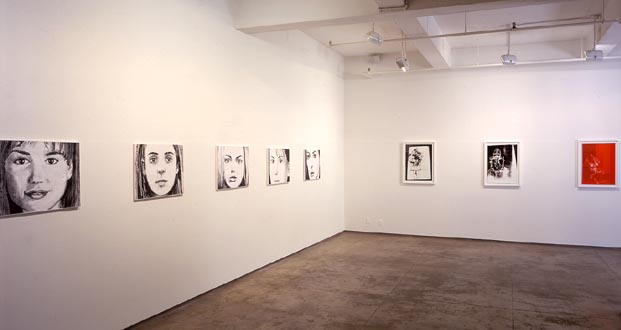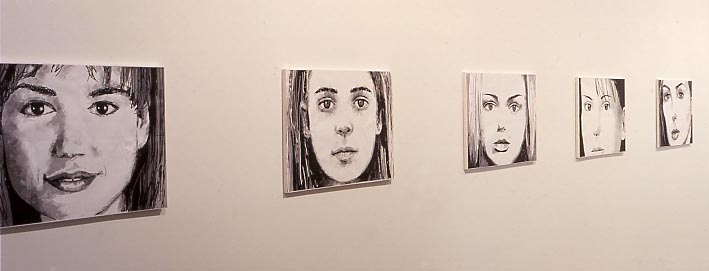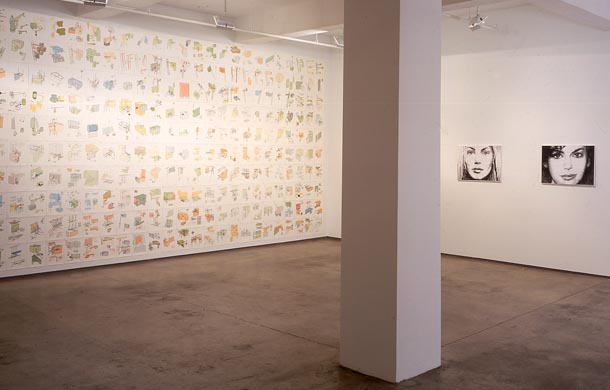Cyber Drawings
Cristinerose Gallery, New York
January - February 2000

Excerpt from "Computer World," by Christian Viveros-Fauné, New
York Press, Feb 2-8, 2000:
Cristinerose Gallery this month presents a lively if slightly uneven exhibition of computerized drawings. Featuring seven artists getting at issues of line and form through magic tools like laptops, word processing programs and scanners, the show, titled "Cyber Drawings," touches upon a widespread ambivalence many artists have with regard to new media. To critique or not critique, that is the question. For the participants of "Cyber Drawings," the impulse to ironically deconstruct exists alongside the fascination of finding skewed use for their sp4nking new cybertools.
"Creatively misusing" the computer, as the gallery release reads, are artists like Marsha Cottrell, who converts the raw material of digital punctuation marks into dense, vaguely architectonic abstractions that resemble schematized cityscapes. Tom Moody’s laser-print Headshots of middlebrow media babes are given subtle, almost imperceptible digital makeovers by means of hand-drawn, mouse-activated editing (the girls have their standard pug noses shortened, their already full lips fleshed out and their eyebrows and eyes brought together). Sculptor Jack Risley combines drawing and scanned-in sketches to output a wall full of drawings in the pastel palette of a recycled Rome bus map. Elliott Green presents a "sketch movie" in a pedestal-mounted aluminum box, its LCD screen crackling with cartoony lines. And Claire Corey presents groovy, swirling colorscape abstractions produced with the aid of high-end graphic programs.
Most eye-fetchingly attractive among the bunch, Corey’s
printouts on watercolor paper alternately give away much of
this show’s production as chiefly experimental and not yet 100
percent ready for primetime. Sharing the funhouse-mirror look
of Karen Davie’s paintings, Corey’s ink-and-paper works look
like a modest if very handsome footnote to the painter’s
better-known book of images.
Gallery Press Release:
Cristinerose Gallery is pleased to announce the opening of "Cyber Drawings," featuring six artists working in digital media: Marsha Cottrell, Elliott Green, Tom Moody, Jack Risley, Pauline Stella Sanchez, and Sean Watson. Running contemporaneously in the Project Room will be an exhibition of digitally-produced paintings by Claire Corey.
As Mark Dery observes in his book Escape Velocity, cyber-culture is a deeply conflicted entity. Many of its participants are exuberantly pro-technology, speaking of paradigm shifts and new levels of consciousness, but at the same time, the Net abounds with neo-primitivist, cyberphobic ranting (for example, Ted Kaczynski's manifesto, a huge hit online). This same ambivalence exists among visual artists: the desire to use new tools competes with the urge to tweak or critique them.
Thus, some artists creatively misuse the computer: Cottrell stretches and layers punctuation marks into dense networks of hair-thin lines, converting the raw material of word processing (peripheral characters from a standard font file) into chaotic or crystalline abstractions. Watson's figure drawings challenge the grid's emotional flatness with agitated lines that crackle like electrical static--a kind of digital Art Brut.
Others work in more traditional ways, taking wry advantage of the computer's ability to mass-produce or subtly enhance imagery. Combining laptop-drawing with the scanning-in of sketches, Risley makes hundreds of drawings recalling the mechanical hybrids of his sculptural pieces; consistent with his interest in found materials, he samples his color palette from a bus map of Rome (where he recently completed a fellowship). In Moody's work, middlebrow media babes are given subtle makeovers--eyes are moved closer together, lips are made fuller--but unlike Hollywood's smooth morphs, the drawing is mostly done by hand (holding a mouse), with a lo-fi office graphics program and laser printer.
Several of the artists straddle more than one medium. Green's short on-screen sketch movies depict the evolution of his cartoony, surrealist graphite drawings--simple curves are laid down, anthropomorphizing details are filled in, whole sections are erased and overdrawn in digital time-lapse. Sanchez augments her crisp computer-generated curves and starbursts with ballpoint squiggles and enigmatic fragments of text.
While drawing (vestigial or otherwise) is the focus of "Cyber Drawings," Corey's pieces in the Project Room are emphatically paintings--simulationist gestural works in high-key color on watercolor paper. Almost impossible to distinguish from paintings in traditional liquid media, these seductive panels nevertheless revel in the manipulations of high-end graphics programs--funhouse mirror distortions, sine curves, and vertiginous illusions of depth.

Excerpt from "Mob Rule," NY Arts, March 2000.
Panelists: John Bjerklie, Carolee Thea, Matt Freedman,
Rupert Goldsworthy, Hildegard Skowasch.
-Did anyone see anything they liked?
-I liked the "Cyber Drawings" show at Cristinerose, particularly Tom Moody's work. I had seen his work before at Uscha Pohl's UP & CO, but I didn't understand it. The work is very crude, very anti-materialist. Warhol said that he wanted to be a machine. I think that in every era when there was some kind of technological, engineering device, or optical device it was always used by artists. I think the way Tom is using it is really quite interesting and much lower key than some of the other artists. He's totally into software, not hardware.
-He's particularly interested in being straightforward and low-tech, but when you see them together they have some potency in a Pop sense.
-But I feel as though they need really some explanation.
-As to why he chose those subjects maybe, because the subjects are all these sexy, young women. It's like, what's this about Tom?
-It seems obsessive.
-To me it was more about the fact that they were all very stereotypical of glamour magazine models, all white, all young, and of a stereotype of glamour. That's part of the content right up front. You walk by a newsstand everyday and that's what you get. And here it was, but it was filtered through this way of looking with a mouse and a computer, which on the computer screen changed the context somewhat.
-But what it seemed it was doing was co-opting it. These to me were the kind of immediate or mindless fantasies you generate out of the flotsam and jetsam that culture leaves with you. All he was doing was using this technology to do the same thing that he could have done with a pencil.
-He distorts them. If you look at those faces closely, they have this excessive dumbness or excessive evilness, or excessive inbred quality.
-Is he romancing the subject matter? Is it passive?
-I think it's critical.
-It seems like revenge, revenge of the nerd. You take the drawing and do your thing to it. It's still a pretty woman, but there's nothing there.
-What about the wall of Jack Risley's drawings? A drawing a day...
-In this show, those are the drawings I found most interesting, but for me, it had little to do with the fact that he used a computer. The fact that he chose the colors from the subway in Rome was more interesting to me than knowing that he did them on a computer.
-They might have been done in colored pencil to greater results.
-He's a methodical guy and one of those people who fell in love with the computer. It almost feels as though these are looser than his sculptures.
-He uses them as a way to sketch, and they are remarkable for
that.
Photos: "Cyber Drawings" installation views. Top of page, left: Tom Moody, Headshots, 2000, five of nine panels. Top, right: drawings by Sean Watson. Middle: detail of top image. Below, left: Jack Risley, A Sculpture in Daily Installments, 1999-2000. Below, right: Tom Moody, Headshots, 2000, two of nine panels.

return to main site